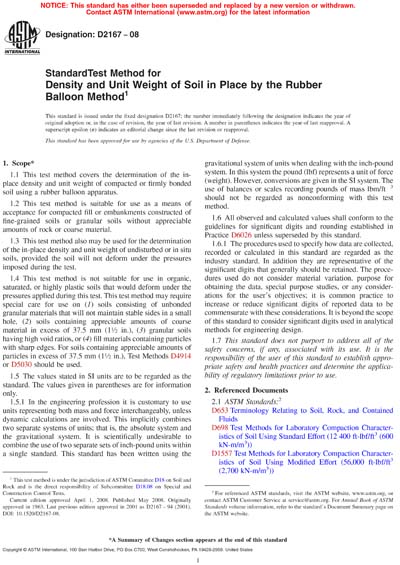Historical
ASTM D2167-08
Standard Test Method for Density and Unit Weight of Soil in Place by the Rubber Balloon Method
1.1 This test method covers the determination of the in-place density and unit weight of compacted or firmly bonded soil using a rubber balloon apparatus.
1.2 This test method is suitable for use as a means of acceptance for compacted fill or embankments constructed of fine-grained soils or granular soils without appreciable amounts of rock or coarse material.
1.3 This test method also may be used for the determination of the in-place density and unit weight of undisturbed or in situ soils, provided the soil will not deform under the pressures imposed during the test.
1.4 This test method is not suitable for use in organic, saturated, or highly plastic soils that would deform under the pressures applied during this test. This test method may require special care for use on (1) soils consisting of unbonded granular materials that will not maintain stable sides in a small hole, (2) soils containing appreciable amounts of coarse material in excess of 37.5 mm (1½ in.), (3) granular soils having high void ratios, or (4) fill materials containing particles with sharp edges. For soils containing appreciable amounts of particles in excess of 37.5 mm (11/2 in.), Test Methods D 4914 or D 5030
1.5 The values stated in SI units are to be regarded as the standard. The values given in parentheses are for information only.
1.5.1 In the engineering profession it is customary to use units representing both mass and force interchangeably, unless dynamic calculations are involved. This implicitly combines two separate systems of units; that is, the absolute system and the gravitational system. It is scientifically undesirable to combine the use of two separate sets of inch-pound units within a single standard. This standard has been written using the gravitational system of units when dealing with the inch-pound system. In this system the pound (lbf) represents a unit of force (weight). However, conversions are given in the SI system. The use of balances or scales recording pounds of mass lbm/ft 3 should not be regarded as nonconforming with this test method.
1.6 All observed and calculated values shall conform to the guidelines for significant digits and rounding established in Practice D 6026
1.6.1 The procedures used to specify how data are collected, recorded or calculated in this standard are regarded as the industry standard. In addition they are representative of the significant digits that generally should be retained. The procedures used do not consider material variation, purpose for obtaining the data, special purpose studies, or any considerations for the user’s objectives; it is common practice to increase or reduce significant digits of reported data to be commensurate with these considerations. It is beyond the scope of this standard to consider significant digits used in analytical methods for engineering design.
1.7 This standard does not purport to address all of the safety concerns, if any, associated with its use. It is the responsibility of the user of this standard to establish appropriate safety and health practices and determine the applicability of regulatory limitations prior to use.
ASTM International [astm]

